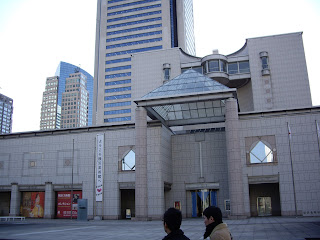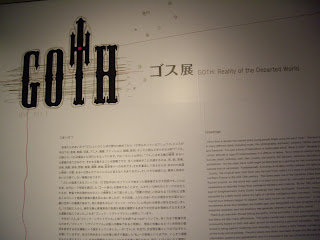This was my first stop on my explorations of museums and it turned out to be much larger then I could fully experience in a day. With a special exhibit and three floors of permanent to semi-permanent exhibitions I only had time to see about three fourths of the museum. The title of the special exhibit was called: わたしいまめまいしたわ現代美術にみる自己と他者 to paraphrase “I am dizzy: Seeing the self and the other through contemporary art.” The museums website takes this title and simplifies it to “Self/Other”, accompanied with this excerpt explain the exhibits purpose: “Today, in the chaos of diversity, how can we pay attention to "the other," the one different from oneself, and accept its values? To begin with, do we "understand" ourselves? This exhibition presents contemporary works from the collections of the national museums that explore new relationships between "the self" and "the other," by reviewing each of the acts of seeing, recognizing, and questioning the subject of such acts.
¹”
The exhibition was then broken up into sections with corresponding titles.


Parts of
ID 400 by Sawada Tomoko 1998
²One of the pieces that really stood out was a photography piece titled “ID 400” by Sawada Tomoko, an artist who lives and works in Kobe. The piece consisted of four large portraits consisting of one hundred 2x2 photo booth pictures. All of the photo’s are of the artist however, she has a very different appearance whether it be make up, clothes, hairstyle, or accessory in each photo. The appearances range from extrovert and introvert looking from global to distinctly Japanese and spanning several time periods. You slowly realize that the pictures are all of one person. By doing this the artist reveals that there is an essence that cannot be changed no matter how much your personality does. The added uniqueness of these photos is the use of a photo booth to create the piece. Living in Japan you become very aware of the amount of photo booths that exist in close proximity to one another. Some for business, passports, and professional use like the one she is using here to the wildly gaudy, cutesy backdrops and design elements of Purikura are all a big part of the culture. Appearances make up so much of who people are in Japan that I felt this piece had a lot to say about how appearances are actually not everything. Here is an excerpt from an interview on this piece.
“The camera for ID pictures, that is my studio, stands inside the parking lot located along the Kobe Subway. As if it were made specially for me, there was a restroom in front of the studio. There, I continued to disguise myself as many different persons as possible, ten to twenty different characters, by wearing the clothes I brought, until the last train passed on the railway. Since it was a public restroom, other people came to use it. My works are in monochrome, so it is not so noticeable, but my make-up made me look unusual. Once a little girl came in and she froze the moment she saw me. Also, a young woman came in and instantly rushed out as if she saw something she should not have seen. I scared away many people.
³”
Hearing this I think back to the times I’ve gotten strange looks or had kids point or run to hide behind their mothers. Amusing nonetheless, her efforts to shed light on the contradiction of personality and identity were well executed.
Another piece from the special exhibition was titled “A Needle Women” by Kimsooja
⁴. four films projected on four walls of a small room play footage of a woman that appears to be of Asian decent with her back to the camera as a steady flow of pedestrians walk towards and away from the camera. The shot is set up almost exactly the same in each film but takes place in four different cities; Mexico City, Cairo, Lagos, and London. After a few seconds you see a steady pattern with the pedestrians making up a palette of a particular race and color that contrasts with women standing in the center. This piece was alone in the final section titled “The self gazing into the self facing society”. The room and the films playing all at once in every direction was disorienting but at the same time put me right in my shoes. I am a Caucasian male living in Japan. The most striking part of the film was the reactions of the pedestrians, as they looked to the women and then to the camera in mild confusion. In London, very few people paid attention to the lady while in Lagos, people crowded around her and openly stared at her if she was from another planet. Simply executed, this piece was very deep in conveying messages of how we see others, how others see us and how we see others viewing ourselves. It seemed to ask are we really that diversified and if so isn’t realizing and accepting our differences important in accepting ourselves. There were lots of artwork that I didn’t get to mention but for my first museum experiences I was feeling very aware of myself and not thinking so much about my intent of discovering some historical influence in modern art (which I did find but found to be not worth mentioning for this first entry).
The permanent gallery was a much more ideal place to explore the historical aspect of modern art in Japan as each section of the gallery was divided into time periods and art movements. The museum focuses on the Meiji era and the huge impact western art had on Japan in this time period. One of the most striking and moving pieces in the collection was Kannon Bodhisattva Riding a Dragon by Harada Naojiro
⁵ done in the style of Western Christian religious, oil on canvas paintings. Being introduced to the style in question it is an extremely bizarre and startling thing to see. Done in a time period when western art forms were being introduced and encouraged in the Meiji era, this painting blends the iconic forms of Buddhism with the religious paintings of the west that forms to make an eerie fantasized version of the subtle and humanistic forms found in previous centuries. This was also during a time period when Shinto was declared the official religion of Japan and old ties between Shinto and Buddhist temples were torn down and some ancient relics destroyed⁶.
The last piece I will mention was done on what is called a
byoubu (屏風⁷)or traditional folding screen. Painting on folding screens is a tradition that goes back 1200 years and had a variety of themes and styles throughout that long history. “A Thousand Cranes” by Kayama Matazo⁸ is a modern screen painting that uses an old medium to create a stunning modern painting. The composition consists of a detailed realistic view of the moon with a flowing wave of outlined shapes of cranes with abstract lines and shapes penetrating them. This is one of the most modern pieces done in the 1970’s and I would say one of the more original pieces that seemed to look for inspiration through traditional Japanese art forms. However, with a design and attention to detail that makes it very modern. It was an incredible balance between a traditional Japanese art form and an original modern piece.
From my first museum visit I was indeed dizzy and worn out from walking all day. I was starting to lose faith in my objective to discover the past in the modern. I was much more interested in mulling over the messages and ideas I had started pertaining about the self and others. With only a book and my own impressions, I wasn’t really sure I could come to any conclusions just yet. I did learn though the collection that the emphasis and push for western art in the Meiji Restoration led to a return to traditional art forms and after mastering western forms of art, a search for the self and a nation through those art forms. Just like in the special exhibit the search for the personal self and how to identify yourself with society is an ongoing theme in today’s world.
References
1. Special Exhibit 1F January 18 - March 9, 2008. The National Museum of Modern Art, Tokyo. March 6, 2008
<http://www.momat.go.jp/english/artmuseum/cal.html>
2. Sawada, Tomoko ID 400. 1998, The National Museum of Modern Art, Tokyo
3. Raho, David "The Many Faces of Tomoko Sawada" The First Word Blog. 17 February 2007. viewed 6 March 2008
<http://daraho.wordpress.com/2007/02/19/the-many-faces-of-tomoko-sawada/>
4. Kimsooja A Needle Woman 1999-2001 Mexico City, Cairo, Lagos, London 2000-2001. The National Museum of Modern Art, Tokyo5. HARADA Naojiro Kannon Bodhisattva Riding the Dragon 1890. Gokukuji Temple, on loan at The National Museum of Modern Art, Tokyo
6. Sadao, Tsuneko S. and Wada, Stephanie. Discovering the Arts of Japan: A Historical Overview. Kodansha International 2003: pp 252-254
7. "byoubu-e" JAANUS Japanese Architecture and Art Net User System 2001. viewed 6 March 2008
<http://www.aisf.or.jp/~jaanus/deta/b/byoubue.htm>
8. Matazo, Kayama A Thousand Cranes 1970. The National Museum of Modern Art, Tokyo














